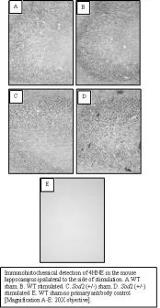SEIZURE INDUCED OXIDATIVE DAMAGE IN THE AMYGDALA KINDLING MODEL OF EPILEPSY
Abstract number :
3.070
Submission category :
Year :
2005
Submission ID :
5876
Source :
www.aesnet.org
Presentation date :
12/3/2005 12:00:00 AM
Published date :
Dec 2, 2005, 06:00 AM
Authors :
1Maithili Sashindranath, 2Karen J. McLean, 3Ian A. Trounce, 1Richard G.H. Cotton, and 2Mark J. Cook
Epilepsy is known to result from complex molecular and biochemical events, most of which have not yet been elucidated. Oxidative stress, mediated by an increase in free radical production, is believed to play a major role in seizure-induced cell death that may cause hippocampal sclerosis, which is particularly common in temporal lobe epilepsy (Patel, 2002, Jefferys, 1999). Oxidative stress can cause severe and irreversible mitochondrial damage. Mitochondrial dysfunction leads to neuronal death, thus presenting a link between seizure-induced oxidative stress and mitochondrial damage.
The hypothesis of this study is that seizures result in increased free radical production; the free-radical induced attack of mitochondrial DNA results in increased mitochondrial DNA mutation that causes hippocampal cell death and consequently cell loss. The cell death may also be related to the cognitive changes seen in some seizure disorders. An immunohistochemical analysis of markers of oxidative damage to DNA, lipids and proteins is being carried out in specimens of mouse tissue sourced initially from wildtype C57BL6 mice and later from superoxide dismutase 2 ([italic]Sod[/italic]2) knockout mice, that have been induced to have seizures via amygdala kindling. Studies will also be performed on tissue from human subjects who have undergone hippocampal resection. Immunohistochemistry has revealed that 4-hydroxy 2-nonenal (4HNE), a marker of lipid peroxidation is present in higher quantities in the brains of kindled mice. Oxidative stress may be an element in ongoing brain injury in people with epilepsy and may also contribute to the enduring seizure state. Modifying such oxidative damage may provide novel neuroprotective strategies in epilepsy.
Our preliminary studies indicate that oxidative stress is definitely present in brains of mice that have been induced to have seizures. In the next few months, we aim to increase our sample size, conduct a similar analysis on human brain tissue and also establish the cellular localization of the markers, in order to determine the effect of the oxidative damage on the mitochondria.
Jefferys, JGR. Hippocampal sclerosis and temporal lobe epilepsy: cause or consequence? [italic]Brain. 1999;[/italic]122:1007-1008.
Patel MN. Oxidative stress, mitochondrial dysfunction, and epilepsy. [italic]Free Radic Res[/italic]. 2002;36:1139-46[figure1] (Supported by Genomic Disorders Research Centre
University of Melbourne
Leslie Eric Paddle Fund for Neurology.)
